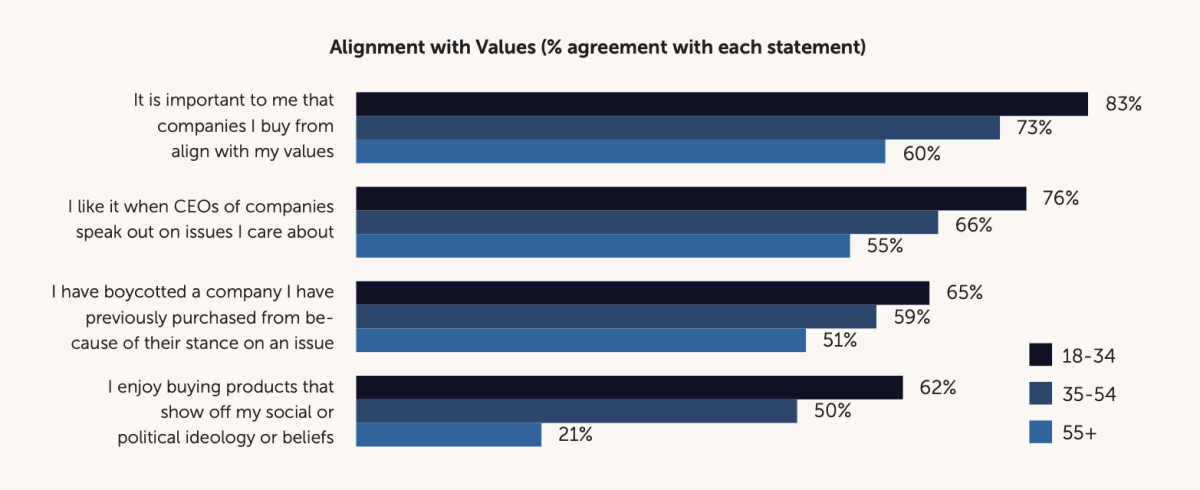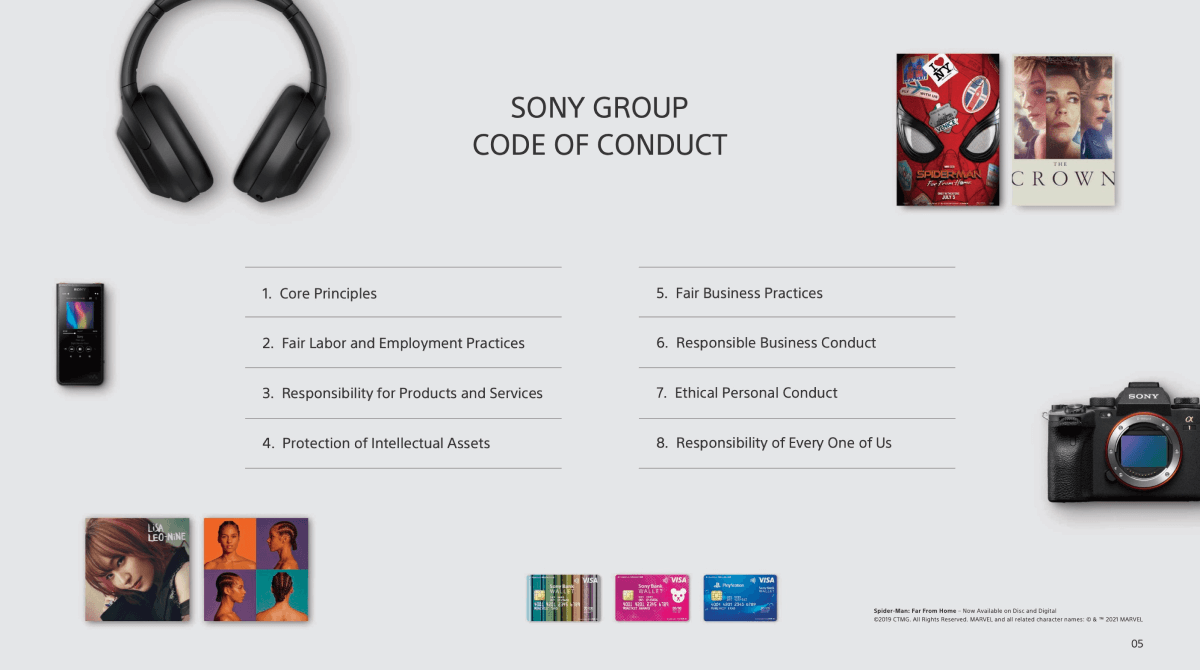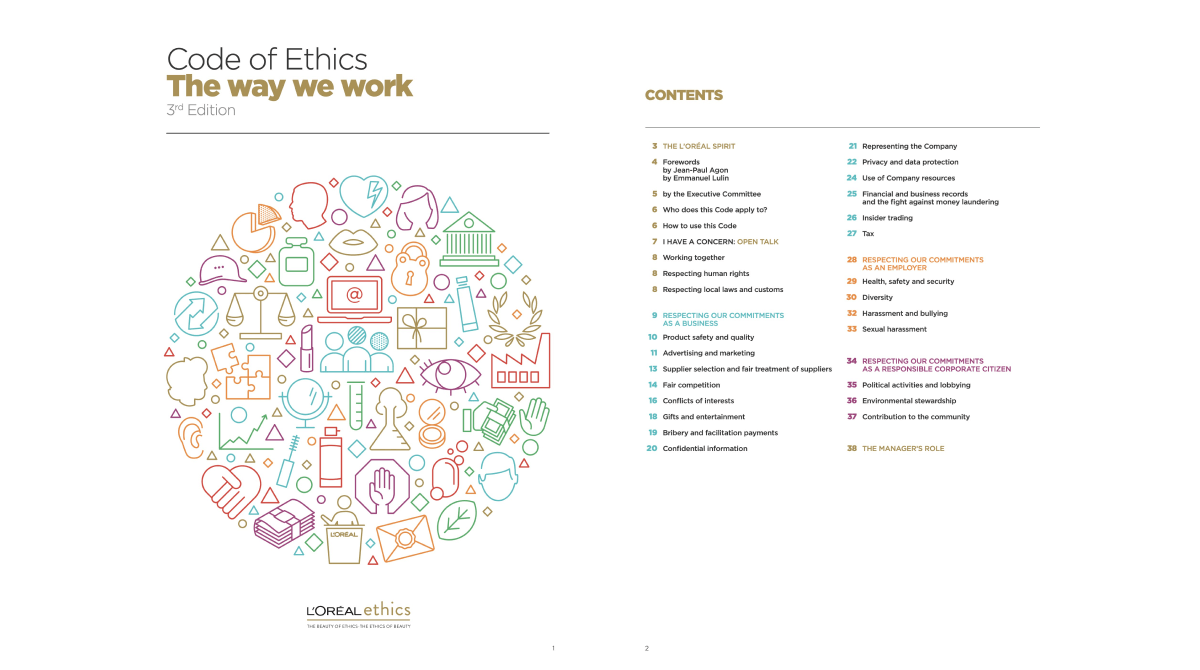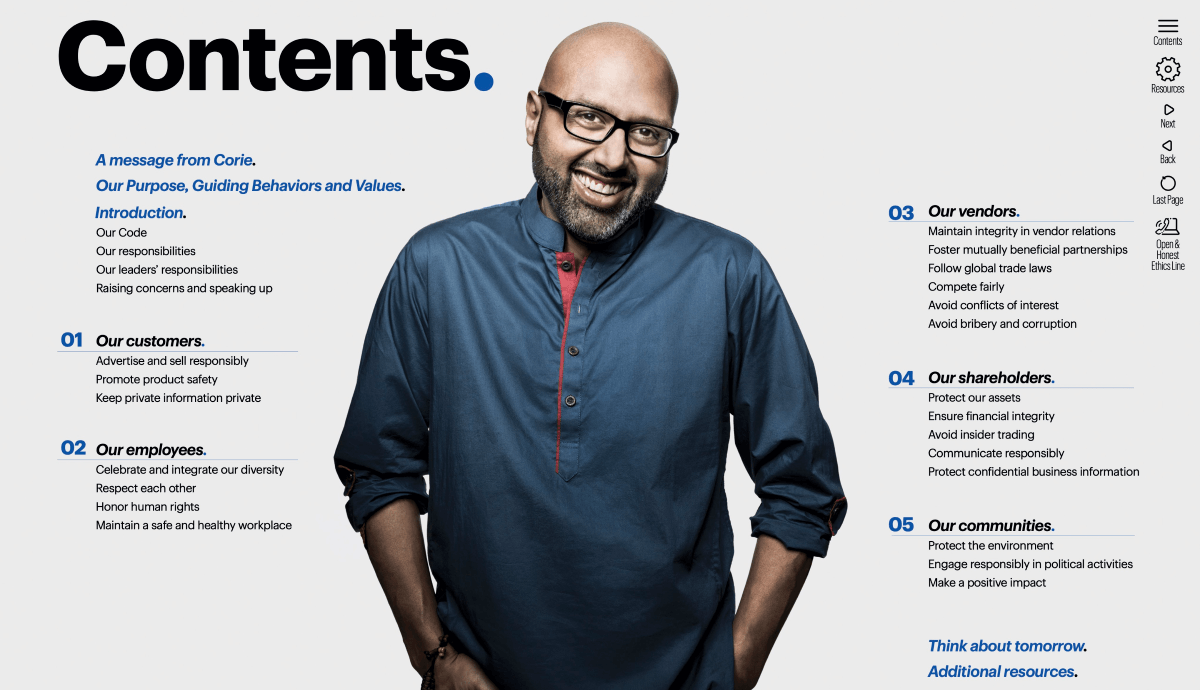Code of Conduct
What is a code of conduct and why is it important? How do you enforce it? With examples from GM, L’Oréal, Sony, and Best Buy.

In this article you will learn:
- What is a code of conduct?
- Why create a code of conduct
- What to include in a code of conduct
- Code of conduct examples
- How to enforce a code of conduct
What is a code of conduct?
It connects broad concepts, such as the company’s mission and core values, with the day-to-day behavior expected from employees.
It reflects the organization’s culture, defining key ethical standards and leadership expectations.
While often used interchangeably with a code of ethics, there is a subtle difference.
- A code of ethics provides broader guidelines to influence employee mindset and decision-making
- A code of conduct focuses more on specific rules and behavior standards.
Most organizations combine both into a single document, rather than having separate ones.
A code of conduct can range from overarching ideals to specific rules. It may cover how employees should align their behavior with the company’s mission or detail specific policies, such as dress code or break times.
It may also address ethical attitudes and communication practices, aiming to prevent conflicts or harassment while clearly outlining the consequences of violating the code.

Build a learning culture: a practical workbook for your organization
Upgrade your organization’s learning culture with clear, actionable strategies to address the challenges.
Download workbookWhy create a code of conduct
A code of conduct is a commitment to self-regulation. It sets clear expectations for employee behavior and the ethical principles that should guide them.
With a code of conduct, the organization establishes a framework for ethical decision-making across all stakeholders. While it won’t solve every dilemma, it gives employees clear guidelines to make better choices in their day-to-day work.
It’s also crucial for compliance and legal policies. For instance, in the U.S., public organizations are required to have a code of conduct. From a compliance perspective, if an employee engages in illegal activity, the code of conduct serves as documentation that they violated company policy.
By creating a code of conduct:
- The employee understands the rules and expectations management has. It defines how to act at work, how to communicate both internally and externally, and helps employees succeed in the company.
- The organization has concrete policies to support compliance training.
- Potential customers and business partners understand the organization’s values.
So far, we have focused on the internal effects of a code of conduct. But creating a code of conduct also has benefits for attracting new customers. Demonstrating the organization’s values and backing them with actions can foster a positive and receptive attitude from potential customers.
A Harvard Business Review survey shows the most significant driver of brand relationships is shared values (64%). Additionally, 5WPR’s 2020 Consumer Culture Report found company values are more important to younger generations. For example, 83% of people aged 18-34 (often described as millennials) agreed with the statement, “It is important to me that companies I buy from align with my values.”

Source: prdaily.com
The report highlights generational differences across several key factors related to value alignment.
Showcasing an organization’s ethics and principles will become increasingly important in today’s marketplace. Creating an honest and accurate code of conduct that reflects the organization’s beliefs is a great way to let customers know who they are supporting with their business.
What to include in a code of conduct
While every business is unique and no two codes of conduct are the same, certain themes and factors are consistently found among successful ones.
Your organization’s specific purpose for adopting a code of conduct will shape its scope. Some companies focus on core values and guidelines to avoid overwhelming employees with too much information. Others take a more comprehensive approach, covering many aspects of behavior and business practices.
Your code of conduct should include guidance on the following areas:
- The values your organization stands for
- Clear guidelines for expected behavior
- Day-to-day business practices
- How employees should interact with external parties
It’s also crucial to outline the procedures and consequences for code violations. While it may be harder to determine a breach of company values, employees should clearly understand the disciplinary process for fixed rules (such as harassment or punctuality violations).
Many codes of conduct begin with a personal letter from the CEO, emphasizing leadership’s commitment to the principles and expectations laid out in the document, adding a human touch.
Below are key elements to consider for inclusion in your code of conduct. These are grouped into four main areas. While it may seem challenging to cover every aspect, especially for new or small businesses, having something in place is better than reacting and defining policies after issues arise.
1. Company values
This section outlines the ethical standards and beliefs that guide the organization. It offers a chance to communicate what the company stands for and how these values are put into practice. Consider including topics such as:
- Business ethics
- Social responsibility
- Environmental responsibility
- Employee rights
- Commitment and accountability
- Diversity and inclusion
2. Employee behavior
This section clarifies expectations regarding how employees should conduct themselves, both in their interactions and in their work performance. It sets standards for professionalism and appropriate behavior. Some key areas to address may include:
- Professional conduct standards
- Policies on discrimination and sexual harassment
- Proper use of company assets
- Guidelines for social media usage
- Rules for communication
- The disciplinary process for violations
3. Internal practices
This section covers the concrete rules governing day-to-day operations. Unlike broader topics like professionalism, internal practices are typically straightforward and easy to follow. Examples of internal practices might include:
- Dress code
- Holiday and leave policies
- Weather-related policies
- Break schedules
- Onboarding procedures
- Job responsibilities
- Training expectations
- Sick leave and injury policies
- Attendance and punctuality rules
- Guidelines for phone use at work
- Employee benefits
- Chain of command
- Legal compliance
4. External practices
This section sets expectations for how employees should engage with external parties, such as customers, clients, or partners. It also covers handling sensitive information or intellectual property. Common topics for external practices include:
- Confidentiality
- Privacy protection
- Intellectual property policies
- Customer communication standards
- Conflict of interest guidelines

Build a learning culture: a practical workbook for your organization
Upgrade your organization’s learning culture with clear, actionable strategies to address the challenges.
Download workbookCode of conduct examples
Listed below are five real-world code of conduct examples from successful companies.
Visa
Multinational financial services corporation Visa has developed a detailed and wide-reaching code of business conduct and ethics with the slogan: “Integrity. Everyday. Everywhere.”

Source: usa.visa.com
It opens with a letter from the CEO stating the company’s commitment to integrity and the need to continually earn the trust of their clients by acting with the highest ethical standards every day. The code of conduct is structured using Visa’s six leadership Principles:
- We lead by example – Be accountable, Treat others with respect, and Demonstrate a passion for our business
- We communicate openly – Promote a shared vision, Communicate effectively, Value other’s perspectives
- We enable and inspire – Inspire Success, Remove barriers, and Value inclusivity and diversity
- We excel with partners – Build strong relationships inside and outside of Visa, Provide excellent customer service, and Take a solutions oriented approach
- We act decisively – Challenge the status quo, Decide quickly, Learn from our mistakes
- We collaborate – Break down silos, Engage with our colleagues, and Deliver as One Team at One Visa
Each section offers essential rules with explanations for implementation, valuable notes, examples, and links to relevant departments and other sources of additional information.
Visa’s code of business and ethics ends with a comprehensive list of resources to help when staff are unsure what to do in any situation. The list of issues or concerns along with the corresponding contact information is impressive and includes:
- Confidential compliance hotline
- Business conduct office
- Conflict of interest program
- HR
- Legal department
- Anti-tax evasion facilitation compliance
- Employee assistance program
Sony
Japanese tech conglomerate Sony has an informative and extensive code of conduct covering many aspects of working at the company.
It starts with Sony’s purpose and core values, followed by messages from both CEO and Executive Vice President, the second of which poses the question:
“Does this contribute to a better future for Sony and a better future for our society?”
This question, along with Sony’s ethical values of Fairness, Honesty, Integrity, Respect, and Responsibility, form the basis of their code of conduct.
From there, the code of conduct is separated into eight areas:
- Core Principles – Honest and Ethical Business Conduct, Relationship with Stakeholders, Respect for Human Rights, and Appreciating Diversity
- Fair Labor and Employment Practices – Equal Employment Opportunity/Non-Discrimination, No Forced Labor/Child Labor, Sound Labor and Employment Practices, and Work Environment (Anti-Harassment/Anti-Discrimination/Health & Safety)
- Responsibility for Products and Services – Product and Service Safety and Accessibility, Advertising and Marketing, and Environmental Conservation
- Protection of Intellectual Assets – Intellectual Property, Confidential or Proprietary Information, Personal Information, and Information Security
- Fair Business Practices – Fair Competition, Trade Controls, Fair Procurement, and Anti-Corruption
- Responsible Business Conduct – Sound Decision Making, Public Disclosure, Recording and Reporting of Information, and Tax Compliance
- Ethical Personal Conduct – Insider Trading, Personal Conflict of Interest, Corporate Asset, and Media Relations and Public statements
- Responsibility of Every One of Us – Reporting Concerns and Hotline and No-Retaliation

Source: sony.com
The code of conduct ends with an explanation of Sony’s ethics and compliance hotline. Maintained by a third party, it allows all employees to report concerns regarding breaks in the law or company policies, with the option to remain anonymous.
General Motors
American automotive company General Motors (GM) have produced a comprehensive yet easy to navigate and understand code of conduct known as “Winning with Integrity.”

Source: investor.gm.com
It begins with an opening message from the chairman and CEO, emphasizing their fundamental commitment to ethical and honest business conduct. Straight after this message is a page dedicated to safety; it places safety for both customers and employees at the heart of everything GM does, noting why this is so critical given the products they make and sell.
The code of conduct then introduces GM’s purpose:
- We earn customers for life
- Our brands inspire passion and loyalty
- We translate breakthrough technologies into vehicles and experiences that people love
- We serve and improve the communities in which we live and work around the world
- We are building the most valued automotive company
And core values:
- Customers
- Relationships
- Excellence
GM separate the code of conduct into four sections containing related topics:
- We follow our code
- We care about others, we put safety first
- We do what’s right
- We protect our company
Each section explains who it applies to, how the code will be enforced, and details the company’s expectations of its employees. It also has a recurring feature known as “Which Way?” that answers questions regarding potential situations where the code should guide the employees to the desired outcome. Finally, the code of conduct ends with some closing thoughts, policy links, and a list of additional resources.
L’Oreal
French cosmetics company L’Oreal has developed an easy to follow code of ethics broken down into four sections:
- The L’Oreal Spirit
- Respecting our commitments as a business
- Respecting our commitments as an employer
- Respecting our commitments as a responsible corporate citizen
“The L’Oreal Spirit” contains forewords by the CEO, Chief Ethics Officer, and the executive committee as a whole stating the commitment of the company to the code of ethics that follows. The remainder of the section contains information regarding who the code is for, how it should be used, how staff should work together, respect for human rights, and local laws and customs.

Source: loreal.com
“Respecting our commitments as a business” details L’Oreals business practices concerning:
- Product safety and quality
- Advertising and marketing
- Supplier selection and fair treatment of suppliers
- Fair competition
- Conflicts of interests
- Gifts and entertainment
- Bribery and facilitation payments
- Confidential information
- Representing the company
- Privacy and data protection
- Use of Company resources
- Financial and business records and the fight against money laundering
- Insider trading
- Tax
The final two sections, “Respecting our commitments as an employer” and “Respecting our commitments as a responsible corporate citizen,” explain company policy regarding how they treat employees and how they interact with the wider world.
Throughout the code, the company lays out its position through clear “We Must” and “We Must Not” lists and provides practical scenarios to demonstrate what they expect from staff. Each section also includes information and suggestions for who to report concerns to for the specific topic.
Best Buy
US electronics retailer Best Buy titled its code of ethics: “At our best. Every Decision. Every Day.”
It begins by describing Best Buy’s belief that “Magic” can happen when you connect each employee with the company’s purpose. Best Buy believes the purpose of a corporation should be to work towards a common good for its:
- Customers
- Employees
- Vendors
- Shareholders
- Community
And these groups form the structure of the code of ethics with a section explaining Best Buy’s responsibilities and policies regarding each of the five.

Source: bestbuy.com
The code continues with a message from the CEO and an introduction to Best Buys:
- Purpose: Enrich lives through technology
- Rallying Cry: Let’s talk about what’s possibleTM
- Guiding Behaviors: Be human, Make it real, and Think about tomorrow
- Values: Unleash the power of our people, Learn from the challenge and change, Show respect, humility, and integrity, and Have fun while being the best
The code of ethics makes it clear who it applies to (every employee), what happens if it is violated, and the responsibilities every employee has. It emphasizes Best Buy’s expectations from its leaders and provides important details on how staff should raise concerns. In addition, Best Buy provides “What If?” examples throughout the code of ethics to show how it works in practice.
How to enforce a code of conduct
Designing and writing a code of conduct is great, but for it to have value it needs to be enforced successfully.
Tip #1. Disseminating a code of conduct
Enforcing a code of conduct starts by disseminating it widely throughout your organization. Need to be aware of the code of conduct to know the organization’s values and behave accordingly.
The most efficient way of spreading your code of conduct is through the employee handbook distributed during onboarding. In general, the process of orienting new employees is a vital time when the code of conduct needs to be made accessible and clearly explained.
Tip #2. Communication channels
In order to enforce the code of conduct, you must provide employees with effective communication channels for reporting violations. Managers should develop a safe and honest relationship with staff, so they feel confident discussing matters with them directly.
However, you should also provide anonymous channels that protect employees reporting problems. For example, if an employee has an issue with a superior or feels threatened and harassed, they may fear retribution and refrain from coming forward. The option of anonymity offers a level of protection for staff with knowledge of code violations and allows for greater enforcement.
Tip #3. Responding to a violation
Once a violation has occurred, you must gather as much information as possible from all parties involved to determine the facts, establish the severity of the issue, and respond accordingly. Consider if any laws have been broken and if other parties (police, attorneys, etc.) need to be involved.
When enforcing your code of conduct and dealing with violations, you must respond in a way that holds true to the values it contains. If leadership does not live up to the expectations defined for employees, it undermines the code of conduct and reduces morale. Always consider how the wider workforce will receive your response.




